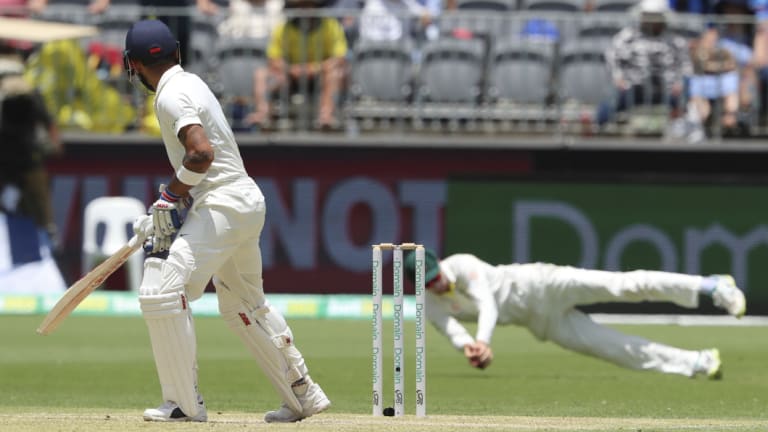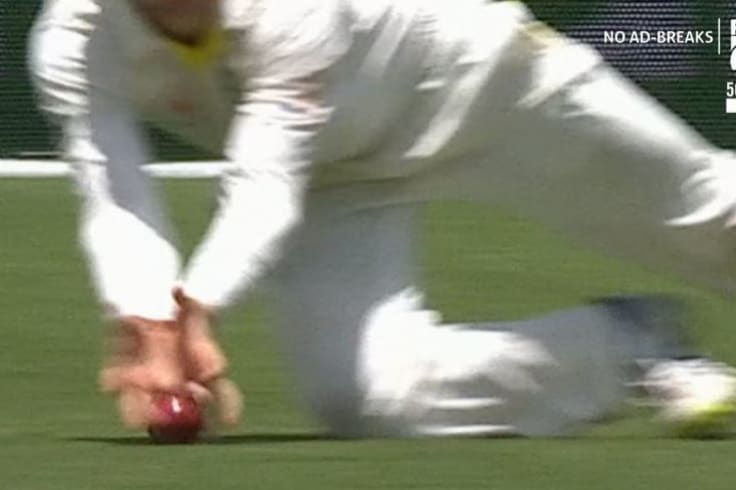Virat Kohli, not known for his reticence, showed admirable restraint as he left the Perth Stadium after his disputed dismissal. The interminable replays and discussion of Peter Handscomb’s catch at second slip show only that technology has not yet completed its conquest and emotion always clouds perception. One billion people think the ball bounced, and 25 million thought it was a catch: the episode is a national inkblot test. But the umpires made a ‘soft’ decision which could not be overruled, and Kohli was out.
Pivotal moment: Virat Kohli looks behind to watch Peter Handscomb take a catch ruled to be legitimate.Credit:AP
A soft decision with rock-hard consequences: the series might well hinge on that moment. Certainly this match did. India trailed by 75 runs with five wickets in hand. Two more hours of Kohli, in total command, could have swung the balance to India. His dismissal would presage a collapse, a deficit for India, and dominance for the hosts. Everyone knew the stakes, not least of all the Indian captain who would play scissors-paper-rock as if his life depended on it.
The many options open to Kohli ranged from a quiet departure to the kind of tantrum an Indian captain threw in Australia 37 years ago when given a poor decision at a critical moment. Sunil Gavaskar tried to take his bat and ball, and his partner, home. The conflagration was stopped by a wise team manager standing at the fence.
Gavaskar, whose name is now on the trophy these teams are playing for, is one of Indian cricket’s moral guardians, issuing judgments from the heavens. So a grimace, a shake of the head, and a grumpy walk formed a statesmanlike response from Kohli. It was bad luck, perhaps, followed by good decision-making, which has been a rarity for India in this Test match.
Touch and go: A video still of the dismissal. Did Peter Handscomb get his fingers underneath the ball?Credit:Fox Sports
The theme that lies behind the Kohli moment is dependency: how India are locked into it and Australia are breaking themselves from it. India were relying on Kohli as Australia once relied on Steve Smith. Everything about the Australians’ approach in this series has been about spreading the burden away from individuals and working as a collective. India, too often, have been relying on outbreaks of brilliance.
The flow of luck has been against India from before the start, when they lost Ravi Ashwin. They lost the toss, putting them in the role of chaser, and their bowlers have gone past the bat so often they must be driven mad. The memory of this match will be of Australian batsmen playing and missing, playing and missing; it is harder to remember how they have made more than 400 runs.
But India have compounded their bad luck with bad decisions. Selecting a fourth seamer instead of Ravindra Jadeja has hurt both their wicket-taking and run-scoring. Their out-cricket – field settings, catching, ground fielding – has been inferior to Australia’s, whose catching, fielding, tactics and attitude have gone a long way to masking other deficiencies.
On the subject of luck, consider Patrick Cummins, who had gone past Indian bats more than any other Australian. Cummins is developing an unfortunate habit of being the unfortunate bowler. But here he was, getting the edge from Kohli, this wicket attaining the significance of the other nine put together.
Here was the difference writ small: Australia relying on all the one-percenters until they add up to a hundred, and India relying on one man to produce the hundred that can make up for everyone else. Cricket is an individual game in a team context. Australia are developing the context, India the individual game. In the circumstances, cricket is lucky that the individual held himself back.
Source: Read Full Article

